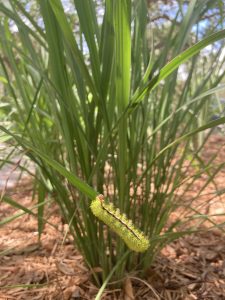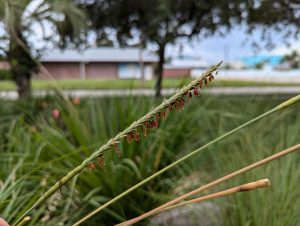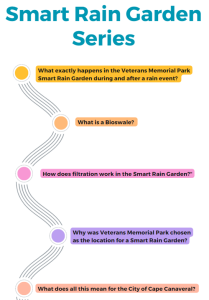 Droppin’ In at the Smart Rain Garden
Droppin’ In at the Smart Rain Garden
#5 in a series of 5 write-ups to introduce the processes and technology at work in the City of Cape Canaveral’s Veterans Memorial Park “Smart” Rain Garden. Please join us for all the posts in this series. The blog series was written by Mandy Baily with assistance from Dan Macchiarella and Tyler Deal with Embry-Riddle Aeronautical University, Zach Eichholz and Tim Carlisle with the City of Cape Canaveral, and Andrew Joesoef with Stetson University. All figures were created, and images taken by Mandy Baily unless otherwise noted.
What does all this mean for the City of Cape Canaveral?
Does water in the bioswale eventually seep into Cape Canaveral’s drinking water? For those unsure, the answer is no. The barrier island’s water comes from the Floridan Aquifer under southeastern Orange County and is transported through the Cocoa FL drinking water system.
By collecting data on stormwater hydrology, the science of water, and its movement, we better understand the dynamics of sheet flow in urban environments and its impacts on human and natural systems. This provides a foundation for planning to maintain and improve the well-being of those in the City of Cape Canaveral. On another note, nature-based water management methods like the green stormwater infrastructure are also an asset to the community for their social and health benefits. For more details on green stormwater infrastructure in the Rain Garden, please see the article Bioswales: Revolutionizing Flood Resilience Using Nature.
A Community Rain Garden

As a community center, the Smart Rain Garden and Veterans Memorial Park is a shady space to walk a dog, meet with friends, enjoy the outdoors, observe surprising wildlife (Figure 1), and join a community event, like weeding or pollinator monitoring. Observations by NSF Team members and community members alike have uncovered an uptick in plant and animal biodiversity.

As the lush, mounding grasses and various flowering plants filled in the slopes and dips of the bioswale this summer (Figure 2), many pollinating insects arrived and stayed to join the resident birds, squirrels, and lizards. This includes the endangered Atala butterfly (Figure 3) and others like the orange Monarchs and yellow Sulphurs, alongside strikingly iridescent metallic bees. Also enjoying the Rain Garden are some exotic invasive critters such as the vibrantly green, tree-dwelling Cuban Knight Anole (the largest anole in the world) (Figure 4) and the Bahamian Curly Tail Lizard, a ground dweller.

Want to Get Involved?
Please join a survey if you want to participate as a community pollinator monitor and wildlife observer. Sessions are held on weekdays from 11:00 a.m. – 1:00 p.m.; days are weather dependent. On-site training is provided. RSVPs are emailed before each survey week (twice monthly, once monthly during cold months). There is no requirement to attend every survey. Please contact UF/IFAS Extension Brevard County Sea Grant Agent Holly Abeels to be added to the email list.

Please see the City of Cape Canaveral’s website and add your name to their events list.
Smart Rain Garden Series
This is the final post in this blog series. Go back to read the other posts in this series.
- What happens in the Veterans Memorial Park Smart Rain Garden during and after a rain event?
- What is a bioswale?
- How does filtration work in the Smart Rain Garden?
- Why was Veterans Memorial Park chosen for a Smart Rain Garden?
 0
0

